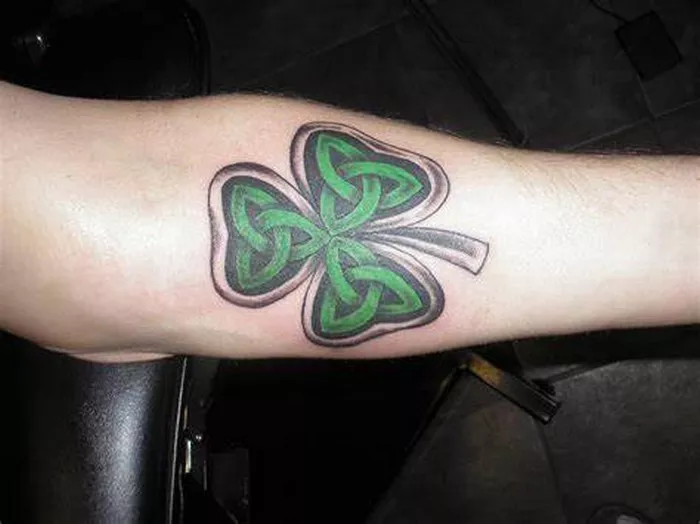Tattoos have long served as significant markers of personal identity and cultural heritage, each design carrying its own unique symbolism and history. Among the rich tapestry of tattoo designs, the Celtic shamrock stands out as a deeply meaningful and visually striking choice. Renowned for its association with Ireland and its Celtic roots, the shamrock holds a plethora of symbolic meanings that resonate with individuals seeking to connect with their heritage, express their beliefs, or simply adorn themselves with a timeless emblem of luck and spirituality.
Origins and Cultural Significance
The origins of the Celtic shamrock trace back to ancient Ireland, where it became intertwined with the island’s cultural and religious practices. The shamrock, often confused with the four-leaf clover yet distinct in its own right, consists of three heart-shaped leaves and is commonly associated with Saint Patrick, the patron saint of Ireland. Legend has it that Saint Patrick used the shamrock to illustrate the Christian doctrine of the Holy Trinity, where each leaf symbolizes the Father, the Son, and the Holy Spirit. This interpretation cemented the shamrock’s place in Irish Christian iconography and imbued it with spiritual significance.
Beyond its Christian associations, the shamrock also holds deep roots in pre-Christian Celtic beliefs. In ancient Celtic mythology, plants and natural elements held sacred meanings, often representing aspects of the natural world and spiritual realms. The shamrock, with its tripartite form, may have symbolized concepts such as the interconnectedness of earth, sea, and sky, or the balance between past, present, and future—a testament to the Celts’ reverence for nature and their complex worldview.
Symbolism and Interpretations
The symbolism of the Celtic shamrock extends beyond its historical origins, resonating with diverse meanings that vary according to personal interpretations and cultural contexts:
1. Luck and Fortune: One of the most prevalent interpretations of the shamrock is its association with luck and good fortune. In Irish folklore, finding a four-leaf clover (often mistaken for the shamrock) is considered a sign of luck. This belief has transcended generations and cultures, making the shamrock a popular motif for those seeking positive vibes and auspicious beginnings in their lives.
2. Spirituality and Faith: For many individuals, particularly those of Irish descent or followers of Christian faiths, the shamrock symbolizes spiritual beliefs and religious devotion. Its association with Saint Patrick and the Holy Trinity underscores its significance as a symbol of faith, unity, and divine protection.
3. Identity and Heritage: Embracing the Celtic shamrock through a tattoo can be a powerful way for individuals to celebrate their Irish heritage or connection to Celtic culture. Whether worn as a proud emblem of ancestry or a nod to shared traditions, the shamrock serves as a visual reminder of one’s roots and cultural identity.
4. Resilience and Growth: The shamrock’s association with nature and renewal also lends itself to interpretations of resilience and personal growth. Like the plant itself, which thrives in adverse conditions and spreads its leaves to flourish, individuals may choose the shamrock tattoo to symbolize their own journey of overcoming challenges and flourishing despite adversity.
See Also: Top 10 Celtic Cross Dragon Tattoo Designs in 2024
Design Elements and Variations
Celtic art is renowned for its intricate patterns and geometric designs, and the shamrock is often depicted within these stylistic frameworks to enhance its visual appeal and symbolic depth. Key design elements of Celtic shamrock tattoos include:
Knotwork: Intricate knots and interlacing patterns that symbolize continuity and interconnectedness.
Spirals and Weaves: Representing cycles of life, eternity, and spiritual evolution.
Triquetra: A triple-knot symbol often incorporated into shamrock designs, emphasizing the unity of three parts.
While traditional Celtic shamrock tattoos feature bold black lines and solid shapes, modern interpretations may include vibrant colors or contemporary tattoo techniques to personalize the design while preserving its cultural essence.
Placement and Personalization
The placement of a Celtic shamrock tattoo can further enhance its significance and visual impact. Common areas for shamrock tattoos include:
Forearm: A visible location that allows for larger designs and easy display.
Ankle: Symbolic of grounding and connection to the earth.
Shoulder: Offering a canvas for intricate designs that can be easily concealed or revealed.
Personalizing a Celtic shamrock tattoo often involves integrating additional elements such as initials, dates, or personal symbols that hold special meaning to the wearer. This customization not only enhances the tattoo’s personal significance but also makes it a unique expression of individual identity and journey.
Cultural Appropriation and Respectful Tattooing
As with any culturally significant tattoo design, it is essential for individuals to approach the Celtic shamrock with respect and understanding of its cultural context. While the shamrock has transcended its origins to become a globally recognized symbol of luck and Irish heritage, it is crucial to avoid appropriating or misinterpreting its meanings. Consulting with a skilled tattoo artist who specializes in Celtic designs can ensure that the tattoo respects the integrity of the symbol while reflecting the wearer’s intentions and personal story.
Conclusion
In conclusion, the Celtic shamrock tattoo continues to captivate individuals worldwide with its rich symbolism, deep-rooted history, and timeless aesthetic appeal. Whether chosen as a nod to Irish heritage, a symbol of faith and spirituality, or simply as a charm for luck and positivity, the shamrock embodies a universal desire for connection, meaning, and personal expression through art. As the art of tattooing evolves and cultural narratives intersect, the Celtic shamrock remains a steadfast emblem of identity, faith, and the enduring legacy of Celtic traditions.

